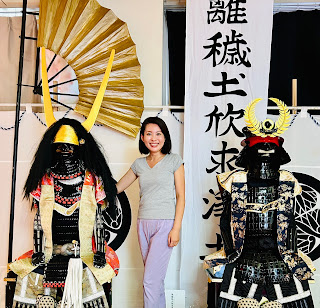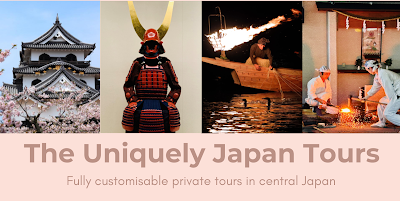Could you tell me a little bit about yourself?
I’m an independent travel adviser and certified tour guide. My mission is to help international travellers who are keen to try out authentic Japanese traditions to design and create deeper travel experiences in Japan.
With 30+ years of living experience in Japan, I have travelled around different parts of the country. I currently offer a 1:1 Japan Travel Program that is designed to identify and create a personalised travel plan based on the interests and needs of individual travellers. Based in the southwestern part of Gifu Prefecture, I also provide fully customisable private tours through which I’m introducing the best of central Japan that showcases Japanese ways of life and unique local culture.
In addition, I’ve been offering the Japan Experts Podcast and other free resources such as travel guides and masterclasses that help international visitors to know more about Japan and plan their trip to Japan.
 |
| The Japan Experts Podcast shares practical tips on how to design your unique trip to Japan |
You have travelled around Japan, and you do offer tours in central Japan. What do you think makes the central region a good place to visit for international visitors?
The first and biggest reason is convenience. The central region is situated in the center of the main island of Honshu, so you can easily stop off in the central region when you travel between the east and the west of the country. In fact, it takes less than 2 hours from Tokyo to Nagoya, the regional hub of central Japan by the high-speed bullet train, while there are many places within the region that you can access via a short 30-minute train ride from Kyoto.
When you visit places beyond major cities and explore rural areas in Japan, you may sometimes find it difficult to get around without a car. The central region has an extensive network of public transport within the region, so it’s easier to access tourist destinations by public transport.
Despite the convenience, the number of international travellers visiting the central region isn’t as high as that of people visiting touristy cities such as Kyoto, so you don’t have to worry about huge crowds of international tourists everywhere you go, which means you have a better chance to experience authentic local life and traditions.
What are some of the attractions you recommend in the central region?
There are a couple of unique characteristics about the central region that are worth knowing. One is the samurai history and the sites highlighting feudal Japan.
The central region is known as the birthplace of Japan’s most renowned samurai warlords who made the effort to unify the country. These samurai warriors and their subordinates built great castles, which functioned as fortified structures during times of war and later became the residence of feudal lords as well as the political center of each feudal domain.
One example of this is Hikone Castle, which is registered as one of Japan’s 5 National Treasure Castles that still remain intact from more than 400 years ago. The castle consists of a main tower, a number of defensive structures, a feudal lord’s garden with tea houses, and the palace museum that exhibits great collections of arts and crafts, armour and swords, and items related to Noh theatre. All these sites demonstrate what the lives of samurai were like during both the times of war and the Edo Period (1603-1868), a 250-year period of peace. These sites are located within walking distance from Hikone Station, which is about half an hour away by train from Kyoto, so it’s a perfect day trip destination.
 |
| A Hikone Castle tour with Miyuki and her guests |
Another site that’s interesting to visit is Sekigahara. It's mostly known for the Battle of Sekigahara in 1600 that completely changed the history of Japan. It was considered the most decisive battle in feudal Japan that brought the Warring States Period (1467-1568) to a close, followed by more than 250 years of peace. What’s important to note is that almost all the major warlords across Japan that lived around the year 1600 either came to Sekigahara to fight or were involved with the battles and disputes that led to the Battle of Sekigahara, and their role in these changed their destiny afterwards. I feel knowing the Battle of Sekigahara should help deepen an understanding of feudal Japan and will be a good foundation to visit whatever Japanese castles or related historical sites you visit.
In Sekigahara, there is the Gifu Sekigahara Battlefield Memorial Museum, which opened in 2020. It is a state-of-the-art museum with digital content that will take you to the battlefield virtually and walk you through every major movement in the battle. The replicas of armour that these samurai warriors are said to have worn in the battle are so distinct from each other and very real so it’s worth checking them out. There is also a place where you can try on a samurai warrior costume with props like a sword or a gun.
 |
| Replicas of samurai armour |
What is the other unique characteristic of the central region you’d like to share?
The other thing that is worth mentioning is that the central region is known as the center of unique local traditions such as sword making, ukai cormorant fishing and kimono fabric tie-dyeing. These skills have been handed down for multiple generations and evolved over time, as passed down from one generation to the next. I feel these skills of the locals and their sustainable lifestyle are a great showcase of Japanese ways of life.
For instance, Gifu City is famous for ukai cormorant fishing on the Nagara River. Ukai is a type of fishing method in which fishermen and trained cormorant birds work together to catch river fish called Ayu. This tradition has lasted for more than 1,300 years and it is a result of deep bonds that are built between the master fisherman and cormorant birds.
 |
| An ukai fishing master with his cormorant birds |
What’s great about the ukai fishing method is that it helps keep fish fresh, as cormorant birds can catch these fish very quickly. The ukai performance is usually held every day from May through October and it’s available to watch from a boat in the evening time.
Ukai was appreciated by renowned historical figures such as Tokugawa Ieyasu (1543-1616) who established the Edo government following his decisive win at the Battle of Sekigahara, and the Emperors of Japan. In fact, the ukai fishermen of the Nagara River are given an honorary position by the Imperial Household Agency.
You guide around these places. Could you talk about your tours and what do you think would be the major benefits of visiting places with a local tour guide?
Thanks for asking this question. I do offer fully customisable private tours in the central region. I feel there are a lot of roles local bilingual guides can play. For example, when designing a tour, I start by listening to the needs of my guests and select places that would make the most of their visit. During the tour, I focus on sharing stories and fun facts that are understandable regardless of prior knowledge in addition to the historical and cultural context that are necessary to know for deeper cultural appreciation. I also make sure to keep communication interactive in the best possible way to arouse the curiosity of my guests.
 |
| Miyuki's private tours are focused on the Japanese way of life and unique local culture |
These are some of the things that I’ve learned from the excellent guides that I have met. When travelling, I always hire a local guide because I believe that’s the best way to experience what each place has to offer efficiently, to appreciate local culture and traditions deeply, and to interact with locals easily. I would love more people to realise these values and spend a day or two with bilingual licensed guides in Japan.
Download her Complete Japan Travel Guide: the 7 steps to creating your unique immersive travel experience
Check out her Japan Experts Podcast and Uniquely Japan Tours

